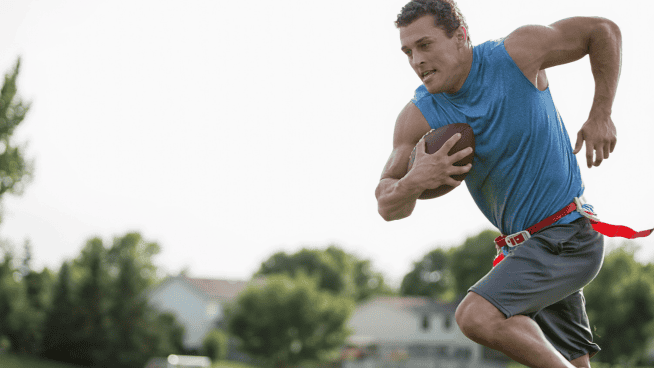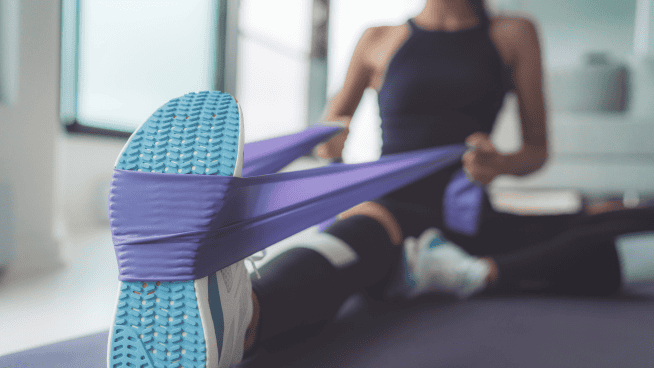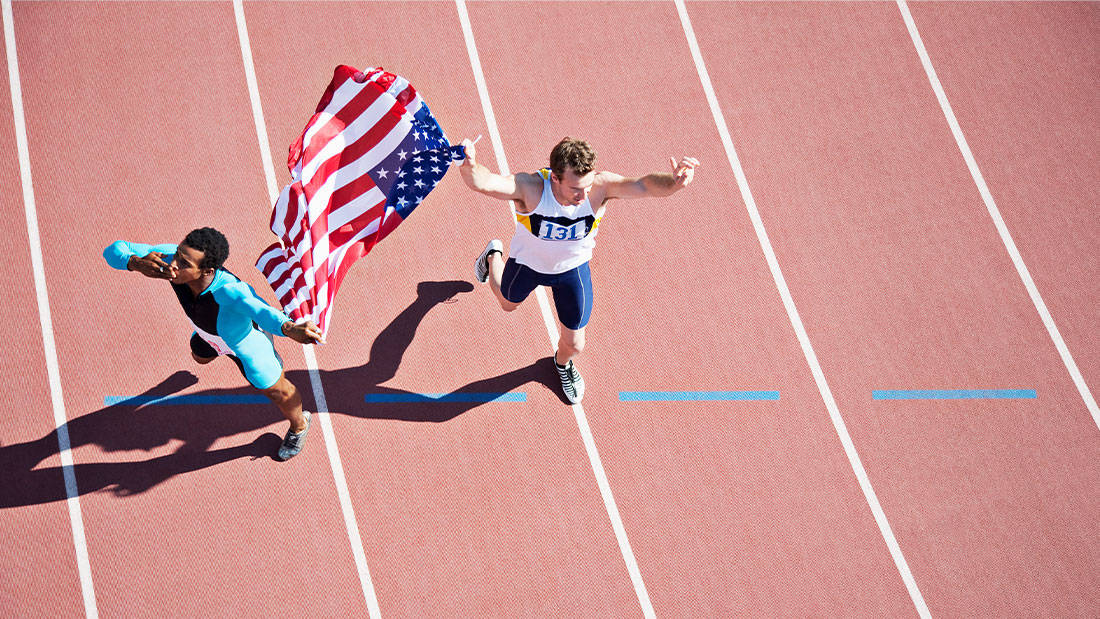Supercharge Your Workouts With Plyometrics
Since the 1950s, plyometrics—or jump training—has been an important component of athletic preparation. These exercises, developed by Russian sports scientist Dr. Yuri Verkhoshansky, were designed to increase muscular power and explosiveness.
Verkhoshansky trained track athletes with Depth Jumps from a box or other elevated surface down to the floor, followed by explosive jumps up. The jumps done in training approximated the biomechanical demands of the takeoff in the triple jump. To otherwise simulate the takeoff, he reasoned, athletes would have to use enormously heavy loads on Barbell Squats.
With Depth Jumps, the body absorbs force from the landing and quickly redirects it into the ground, providing upward thrust for the second jump.
Verkhoshansky’s new form of training, initially termed “Shock Training,” caught on quickly and changed the design of strength and conditioning programs.
Coaches and athletes soon incorporated Shock Training into their programs, but unfortunately they initially underestimated the demands that Depth Jumps imposed on the body.
When it relates to plyometric training, “more” certainly does not mean “better.” Coaches and athletes should view plyometric exercises as powerful training tools, but to work well, they must be strategically inserted into strength and conditioning programs. Plyometric exercises have no business appearing in someone’s WOD (Workout of the Day), and they should never serve as substitutes for traditional compound exercises.
The Science Behind Plyometrics
You may already be familiar with the physiological bases of plyometrics. But here are some key points if you need a refresher:
- Plyometric exercises involve the stretch-shortening cycle, or SSC.
- The SSC is comprised of a rapid eccentric muscle action that stretches the elastic structure of muscles and tendons, immediately followed by a quick and powerful concentric (or resistance) muscle action.
- Nerves lining the muscles that transition from a stretching to resistance action relay kinesthetic information such as muscular tension and length to the central nervous system.
- The concentric muscle action is triggered by the stretch reflex that shortens a muscle when it becomes rapidly stretched.
We can conclude that the SSC, coupled with resistance muscle action, increases the amount of force, and that this increased output can help sharpen the central nervous system and increase muscle power, improving athletic performance.
Benefits of Plyometrics
1. A recent study by researchers at the University of Delaware revealed that Single-Leg Hurdle Hops significantly activated the glutes and hamstring muscles during takeoff and landing of jumps.
Practical Application: Performing jumping exercises before strength training may prove helpful in activating muscles involved during lifts.
2. A study involving professional rugby players showed that a series of plyometric jumps performed prior to countermovement jumps (where the jumper starts by standing, flexes at the knees and hips, then jumps up) improved the height and peak force of the countermovement jumps.
Practical Application: Performing jumps before a training session or competition during a warm-up may improve performance.
3. A study analyzing the effects of a high-volume jumping protocol (involving 10 sets of 10 Squat Jumps) revealed that the fibers of fast-twitch muscles (muscles that contract and tire quickly) sustained the greatest amount of damage.
Practical Application: Plyometric exercises involve the rapid activation of fast-twitch muscle fibers. Performing a set or two of low-rep Squat Jumps before lower-body training may help reactivate fast-twitch muscle fibers during Squats and Deadlifts.
4. A study of Depth Jumps performed before the establishment of a one-rep maximum Squat noted improvements in performance in the jump groups versus the control group. The group that jumped from 30 cm showed the greatest improvement in Squat performance. An earlier study, also involving Depth Jumps, confirmed their capacity to improve Squat performance.
Practical Application: Depth Jumps performed from lower heights (approximately 30 cm) may improve lower-body strength performance.
5. A study involving 12 male college athletes revealed that performing two plyometric Push-Ups or two Medicine Ball Chest Passes 30 seconds before a one-rep-max Bench Press improved performance.
Practical Application: Plyometric Push-Ups and Explosive Medicine Ball Tosses may be effective in activating the muscles of the chest, deltoids and triceps. Furthermore, the Plyo Push-Ups and Med Ball Tosses could serve as useful tools for teaching movement intention. Though the load on the bar may be heavy relative to the lifter, the goal of any one-rep-maximum exercise is to move the bar with great speed.
Plyometrics Workout Considerations
- Never perform warm-up plyometrics at a high volume or to failure. Perform immediately before the first strength exercise of the day.
- Warm-up plyometrics should mimic the demands of the strength exercises you will perform next. For instance, do Broad Jumps before Deadlifts, Squat Jumps before Squats, and Supine Med Ball Tosses or Plyometric Push-Ups before Bench Presses.
- Limit the number of reps to five or fewer to make sure you are executing them properly and avoiding neuromuscular fatigue.
- Plyometric exercises can be performed beyond the warm-up, either between sets of the first strength exercise or before maximum attempts.
- Strength athletes should never perform plyometrics during deloads.
- Other athletes should reduce the volume of plyometric training during the course of the season.
- Before including plyometrics in a program that includes warm-ups, you should be capable of benching at least your own body weight and squatting and deadlifting at least 1.5 times your body weight.
- Plyometric training enhances tendon stiffness, causing your body to rely on your muscles to absorb and redirect force. Keep in mind that stiffness means more stability and more stability leads to greater strength.
- Reduce or eliminate plyometrics from your warm-ups if you are already performing them separately in your training.
Read more:
- Build Your Explosive Lower-Body Plyometric Program
- Are Plyometrics Right for You?
- Elite Performance With Mike Boyle: Hidden Benefits of Lower-Body Plyos
Photo: pankostrengthandspeed.com
RECOMMENDED FOR YOU
MOST POPULAR
Supercharge Your Workouts With Plyometrics
Since the 1950s, plyometrics—or jump training—has been an important component of athletic preparation. These exercises, developed by Russian sports scientist Dr. Yuri Verkhoshansky, were designed to increase muscular power and explosiveness.
Verkhoshansky trained track athletes with Depth Jumps from a box or other elevated surface down to the floor, followed by explosive jumps up. The jumps done in training approximated the biomechanical demands of the takeoff in the triple jump. To otherwise simulate the takeoff, he reasoned, athletes would have to use enormously heavy loads on Barbell Squats.
With Depth Jumps, the body absorbs force from the landing and quickly redirects it into the ground, providing upward thrust for the second jump.
Verkhoshansky’s new form of training, initially termed “Shock Training,” caught on quickly and changed the design of strength and conditioning programs.
Coaches and athletes soon incorporated Shock Training into their programs, but unfortunately they initially underestimated the demands that Depth Jumps imposed on the body.
When it relates to plyometric training, “more” certainly does not mean “better.” Coaches and athletes should view plyometric exercises as powerful training tools, but to work well, they must be strategically inserted into strength and conditioning programs. Plyometric exercises have no business appearing in someone’s WOD (Workout of the Day), and they should never serve as substitutes for traditional compound exercises.
The Science Behind Plyometrics
You may already be familiar with the physiological bases of plyometrics. But here are some key points if you need a refresher:
- Plyometric exercises involve the stretch-shortening cycle, or SSC.
- The SSC is comprised of a rapid eccentric muscle action that stretches the elastic structure of muscles and tendons, immediately followed by a quick and powerful concentric (or resistance) muscle action.
- Nerves lining the muscles that transition from a stretching to resistance action relay kinesthetic information such as muscular tension and length to the central nervous system.
- The concentric muscle action is triggered by the stretch reflex that shortens a muscle when it becomes rapidly stretched.
We can conclude that the SSC, coupled with resistance muscle action, increases the amount of force, and that this increased output can help sharpen the central nervous system and increase muscle power, improving athletic performance.
Benefits of Plyometrics
1. A recent study by researchers at the University of Delaware revealed that Single-Leg Hurdle Hops significantly activated the glutes and hamstring muscles during takeoff and landing of jumps.
Practical Application: Performing jumping exercises before strength training may prove helpful in activating muscles involved during lifts.
2. A study involving professional rugby players showed that a series of plyometric jumps performed prior to countermovement jumps (where the jumper starts by standing, flexes at the knees and hips, then jumps up) improved the height and peak force of the countermovement jumps.
Practical Application: Performing jumps before a training session or competition during a warm-up may improve performance.
3. A study analyzing the effects of a high-volume jumping protocol (involving 10 sets of 10 Squat Jumps) revealed that the fibers of fast-twitch muscles (muscles that contract and tire quickly) sustained the greatest amount of damage.
Practical Application: Plyometric exercises involve the rapid activation of fast-twitch muscle fibers. Performing a set or two of low-rep Squat Jumps before lower-body training may help reactivate fast-twitch muscle fibers during Squats and Deadlifts.
4. A study of Depth Jumps performed before the establishment of a one-rep maximum Squat noted improvements in performance in the jump groups versus the control group. The group that jumped from 30 cm showed the greatest improvement in Squat performance. An earlier study, also involving Depth Jumps, confirmed their capacity to improve Squat performance.
Practical Application: Depth Jumps performed from lower heights (approximately 30 cm) may improve lower-body strength performance.
5. A study involving 12 male college athletes revealed that performing two plyometric Push-Ups or two Medicine Ball Chest Passes 30 seconds before a one-rep-max Bench Press improved performance.
Practical Application: Plyometric Push-Ups and Explosive Medicine Ball Tosses may be effective in activating the muscles of the chest, deltoids and triceps. Furthermore, the Plyo Push-Ups and Med Ball Tosses could serve as useful tools for teaching movement intention. Though the load on the bar may be heavy relative to the lifter, the goal of any one-rep-maximum exercise is to move the bar with great speed.
Plyometrics Workout Considerations
- Never perform warm-up plyometrics at a high volume or to failure. Perform immediately before the first strength exercise of the day.
- Warm-up plyometrics should mimic the demands of the strength exercises you will perform next. For instance, do Broad Jumps before Deadlifts, Squat Jumps before Squats, and Supine Med Ball Tosses or Plyometric Push-Ups before Bench Presses.
- Limit the number of reps to five or fewer to make sure you are executing them properly and avoiding neuromuscular fatigue.
- Plyometric exercises can be performed beyond the warm-up, either between sets of the first strength exercise or before maximum attempts.
- Strength athletes should never perform plyometrics during deloads.
- Other athletes should reduce the volume of plyometric training during the course of the season.
- Before including plyometrics in a program that includes warm-ups, you should be capable of benching at least your own body weight and squatting and deadlifting at least 1.5 times your body weight.
- Plyometric training enhances tendon stiffness, causing your body to rely on your muscles to absorb and redirect force. Keep in mind that stiffness means more stability and more stability leads to greater strength.
- Reduce or eliminate plyometrics from your warm-ups if you are already performing them separately in your training.
Read more:
- Build Your Explosive Lower-Body Plyometric Program
- Are Plyometrics Right for You?
- Elite Performance With Mike Boyle: Hidden Benefits of Lower-Body Plyos
Photo: pankostrengthandspeed.com











